MODELING PRODUCTIVITY AND PROFITABILITY FOR SMALLHOLDER TILAPIA AND SHRIMP POLYCULTURE IN JAVA
Introduction
Aquatic polyculture is re-emerging globally as a promising system to optimize yield and profit (Knowler et al., 2020), including in Java, Indonesia. Among smallholder farmers in Java, tilapia-shrimp polyculture is one of the chosen species combinations (Setyawan et al., 2022a). However, optimizing profit in tilapia-shrimp polyculture systems remains a challenge due to the underexplored effects of management decisions on species interactions, which influence productivity and profitability. The objectives of this study are to (1) develop a multispecies bioeconomic model for pond production of tilapia and shrimp that incorporates species interactions and (2) validate the model outputs.
Materials and methods
The multispecies bioeconomic model was developed through a literature review and insights from a scoping visit in Java. Model inputs are based on management parameters that farmers can influence: feed, stocking density, stocking weight, and culture duration. The model operates on two levels: (1) the individual species level which produces daily weight gain as output, and (2) the pond level which incorporates interaction effects from the other species and produces biomass, daily mortality, and cumulative mortality for each species as outputs. The final outputs are total production and operating profit expressed in USD/m2/year. The model was programmed in R software version 4.3.2 (R Core Team, 2023) as a simulation tool. Expert validation of model projection was conducted for six scenarios (Table 1). Four scenarios with average feeding rate and (1) low tilapia and low shrimp density (LT-LS), (2) low tilapia and high shrimp density (LT-HS), (3) high tilapia and low shrimp density (HT-LS), or (4) high tilapia and high shrimp density (HT-HS), and 2 scenarios with average stocking density and (5) low feeding rate (LFR), or (6) high feeding rate (HFR).
Results
In the stocking density scenarios, higher tilapia stocking density led to lower tilapia harvest weights, regardless of shrimp density (Table 2). For shrimp, higher tilapia density or lower shrimp density increased harvest weights due to greater feed availability. Experts validated tilapia harvest weights as realistic across all scenarios but noted that shrimp harvest weights in LT-HS and HT-HS appear to be underestimated. Higher stocking density raised the cumulative mortality of the same species. Higher shrimp densities slightly reduced tilapia mortality (Table 2). But higher tilapia density slightly increased shrimp mortality. Experts remarked that tilapia cumulative mortality appeared to be overestimated at high densities, while shrimp mortality was within a realistic ranges.
Under the HFR scenario, tilapia growth was 2.7 times faster to a harvest weight of 205 grams (Table 2), and shrimp harvest weights were 3.8 times higher than under LFR. Experts agreed with the faster tilapia growth at higher feeding rates but pointed out that shrimp harvest weights under LFR appear to be underestimated. Operating profit under HFR was USD 1.54 higher than under LFR (Table 2), though experts cautioned that this large difference may indicate model overestimation.
Discussion
The lower than expected shrimp harvest weights can be attributed to a lower realized feeding rate from uneaten tilapia feed, a low and constant natural feed availability assumed by the model, and potentially unrealistic estimates for the effect of stocking density and FCR used to calculate economic FCR. Experts expected tilapia cumulative mortality of around 30% in the HT-LS and HT-HS scenarios. The discrepancy arises because the daily mortality model links higher biomass to higher daily mortality rates. Experts also noted that mortality is typically higher in the early weeks after stocking for both species due to biological vulnerability. The annual operating profit projected under the HFR scenario appears high. The model focuses on the effects of species interactions on the total economic performance, and does not account for the effects of disease and other risks which will likely reduce the annual profit when they affect the pond. The main aim for the model is to assess the effects of management choices on the technical and economic performance. Availability of the data on the performance of polyculture ponds is limited which, when available, will allow finetuning of the model parameters, especially for growth on natural feed and for the interaction effects on mortality.
Conclusions
The model performs well to predict the effects of management choices on tilapia growth. Shrimp growth appears to be underestimated in some scenarios, especially with low feeding rate. Projections of mortality appear realistic in most cases, but mortality under high tilapia stocking densities tends to be overestimated. Currently, the model could serve as a tool for assessing the tilapia-shrimp polyculture, supporting food production and economic stability for smallholder farmers.
References
Knowler, D., Chopin, T., Martínez-Espiñeira, R., Neori, A., Nobre, A., Noce, A., Reid, G. 2020. The economics of integrated multi-trophic aquaculture: where are we now and where do we need to go? Reviews in Aquaculture, 12(3): 1579–1594. https://doi.org/10.1111/raq.12399.
Setyawan, P., Imron, I., Gunadi, B., van den Burg, S., Komen, H., Camara, M. 2022a. Current status, trends, and future prospects for combining salinity tolerant tilapia and shrimp farming in Indonesia. Aquaculture, 561: 738658. https://doi.org/10.1016/j.aquaculture.2022.738658.

